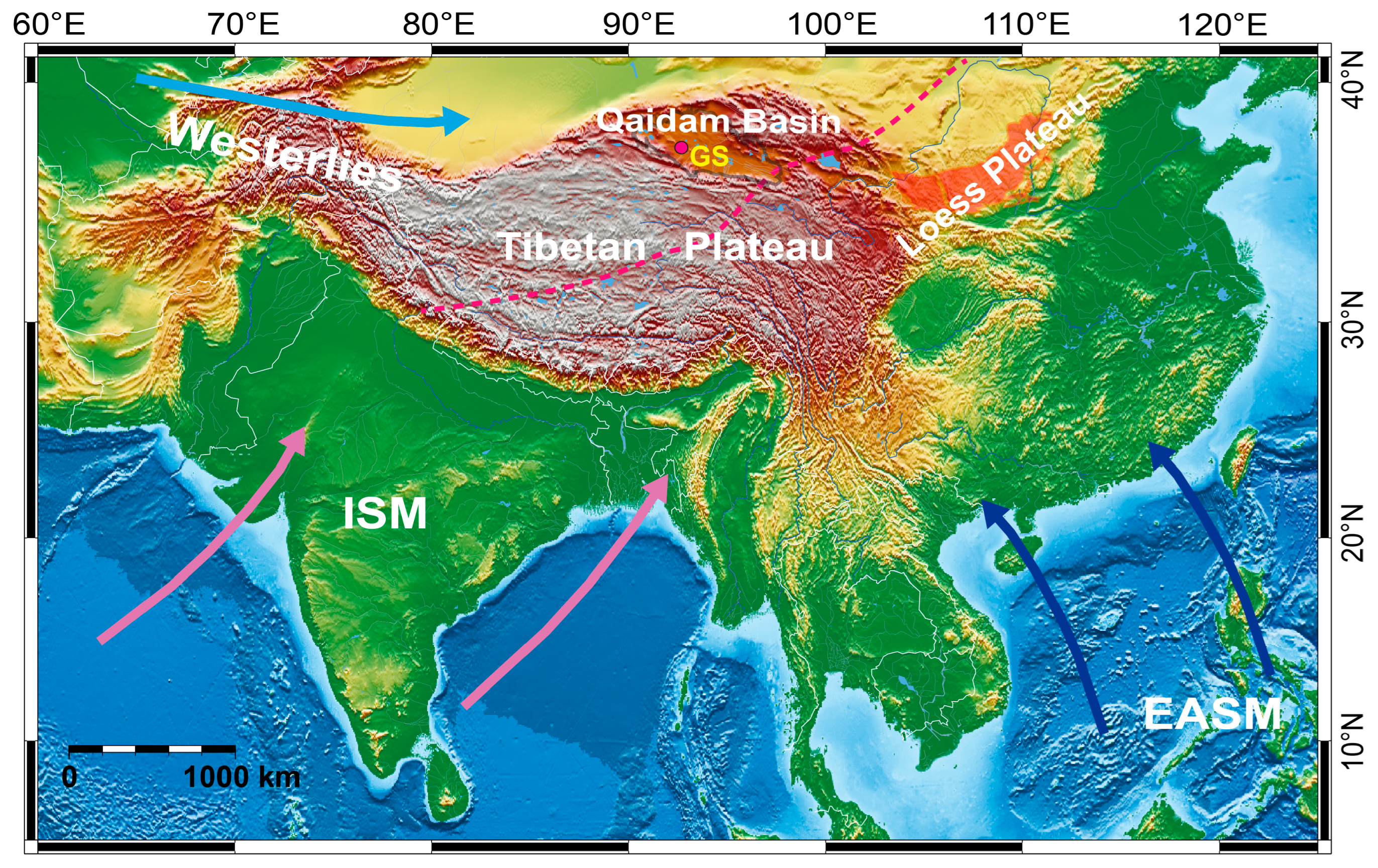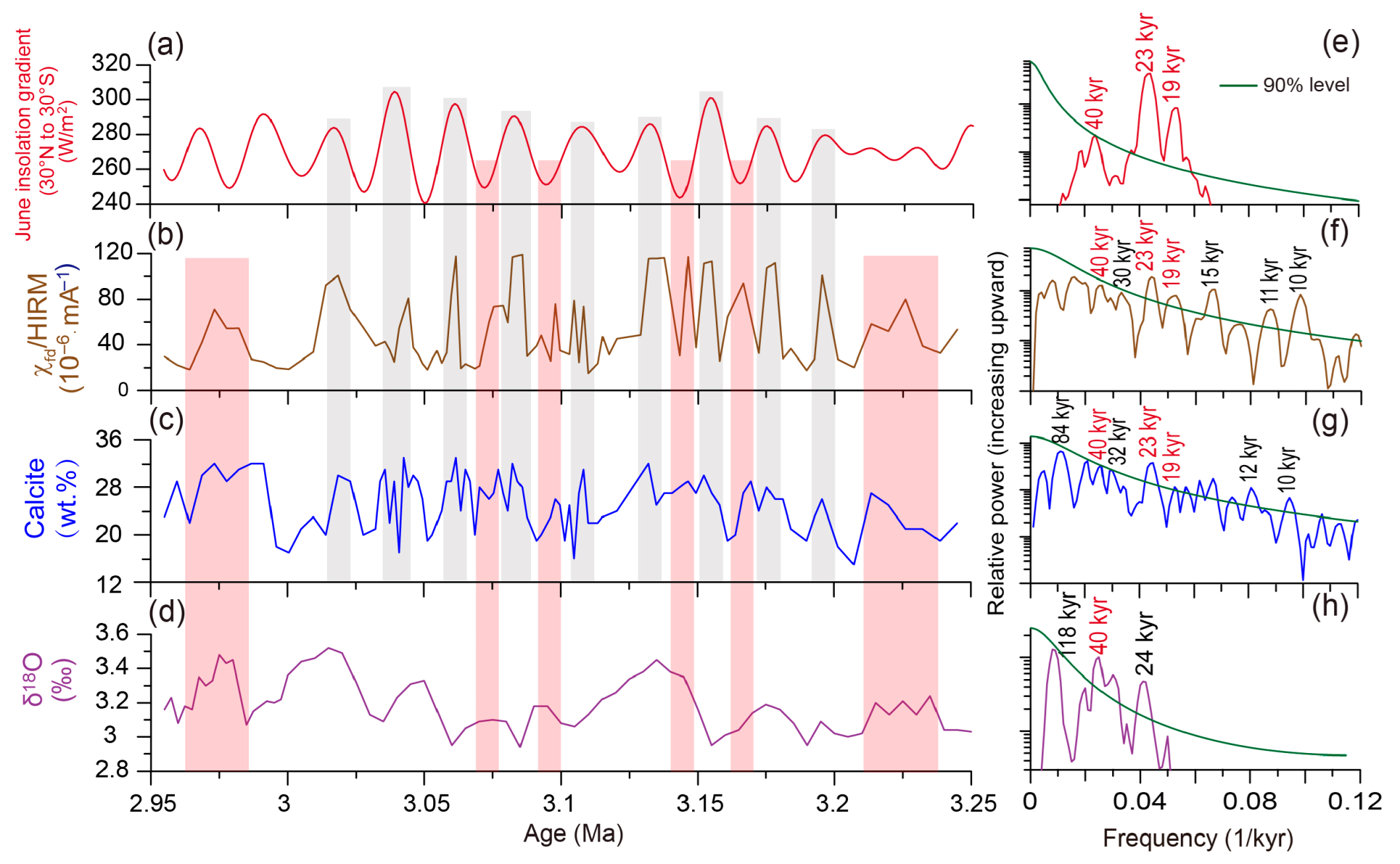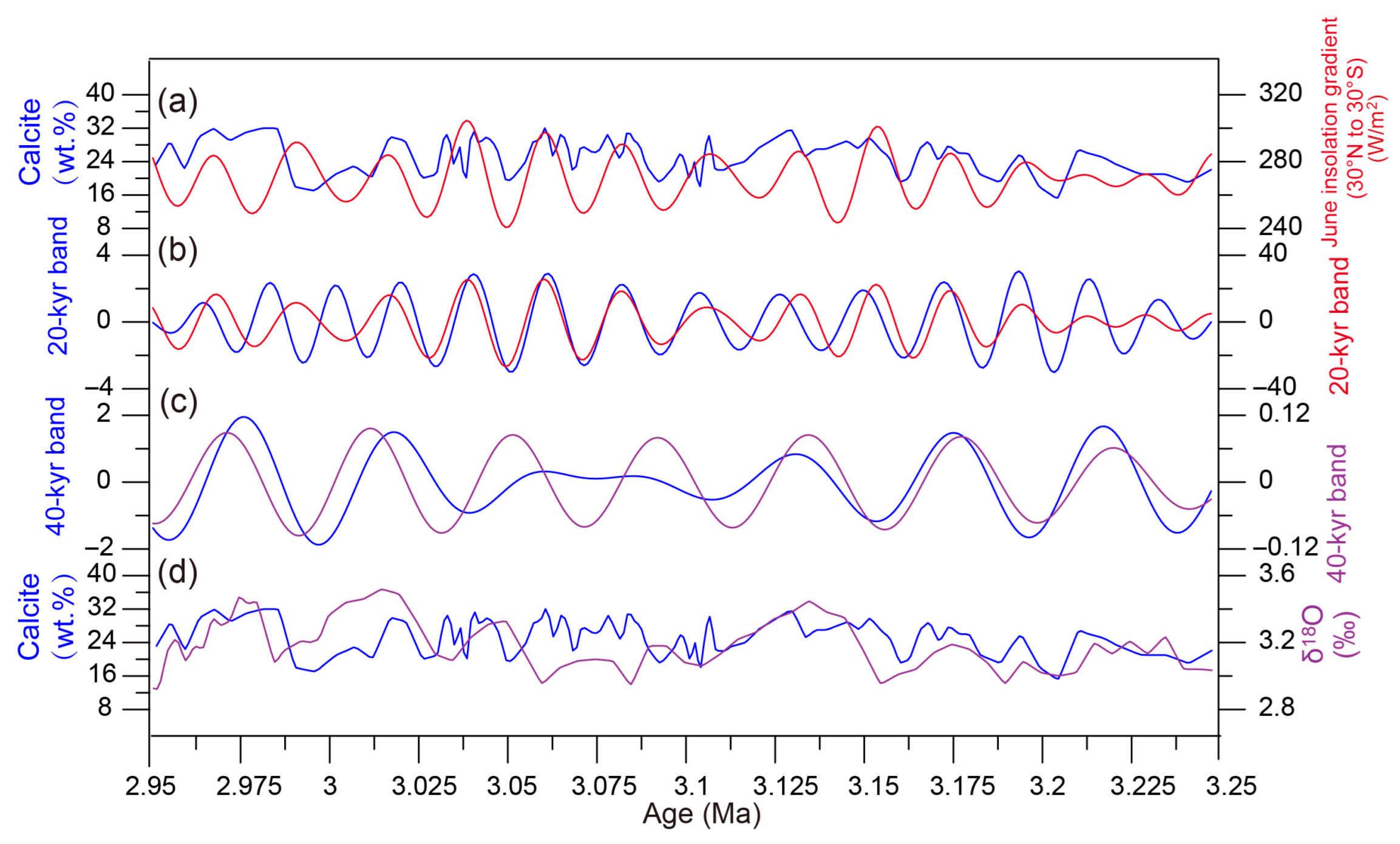Evaporite Mineral Evidence for the Dry–Wet Variations in the Mid-Pliocene Warm Period in the Qaidam Basin
Abstract
1. Introduction
2. Geologic Setting
3. Materials and Methods
4. Results
5. Discussion
5.1. Environmental Implications of Evaporite Minerals Records
5.2. The Dry–Wet Variations in the Qaidam Basin During the Mid-Pliocene Warm Period
6. Conclusions
Author Contributions
Funding
Institutional Review Board Statement
Informed Consent Statement
Data Availability Statement
Acknowledgments
Conflicts of Interest
References
- Qu, Y.P.; Lv, J.; Su, Z.C.; Sun, H.Q.; Ma, M.M. Research review and perspective of drought mitigation. J. Hydraul. Eng. 2018, 49, 115–125. (In Chinese) [Google Scholar]
- Held, I.M.; Soden, B.J. Robust Responses of the Hydrological Cycle to Global Warming. J. Clim. 2006, 19, 5686–5699. [Google Scholar] [CrossRef]
- Seager, R.; Ting, M.; Held, I.; Kushnir, Y.; Lu, J.; Vecchi, G.; Huang, H.P.; Harnik, N.; Leetmaa, A.; Lau, N.C.; et al. Model projections of an imminent transition to a more arid climate in southwestern North America. Science 2007, 316, 1181–1184. [Google Scholar] [CrossRef]
- Zeng, N.; Yoon, J. Expansion of the world’s deserts due to vegetation-albedo feedback under global warming. Geophys. Res. Lett. 2009, 36, L17401. [Google Scholar] [CrossRef]
- Overpeck, J.; Udall, B. Dry Times Ahead. Science 2010, 328, 1642–1643. [Google Scholar] [CrossRef]
- Feng, S.; Fu, Q. Expansion of global drylands under a warming climate. Atmos. Chem. Phys. 2013, 13, 10081–10094. [Google Scholar] [CrossRef]
- Sherwood, S.; Fu, Q. A Drier Future? Science 2014, 343, 737–739. [Google Scholar] [CrossRef]
- Li, Y.; Huang, J.P.; Ji, M.X.; Ran, J.J. Dryland Expansion in Northern China from 1948 to 2008. Adv. Atmos. Sci. 2015, 32, 870–876. [Google Scholar] [CrossRef]
- Huang, J.P.; Yu, H.P.; Guan, X.D.; Wang, G.Y.; Guo, R.X. Accelerated Dryland Expansion under Climate Change. Nat. Clim. Change 2016, 6, 166–171. [Google Scholar] [CrossRef]
- Miao, L.J.; Li, S.Y.; Zhang, F.; Chen, T.X.; Shan, Y.P.; Zhang, Y.S. Future drought in the dry lands of Asia under the 1.5 and 2.0 °C warming scenarios. Earths Future 2020, 8, e2019EF001337. [Google Scholar] [CrossRef]
- Li, G.Q.; Chen, F.H.; Xia, D.S.; Yang, H.; Zhang, X.J.; Madsen, D.B.; Oldknow, C.; Wei, H.; Rao, Z.; Qiang, M. A Tianshan Mountains Loess–Paleosol Sequence Indicates Anti-Phase Climatic Variations between Arid Central Asia and East Asia. Earth Planet. Sci. Lett. 2018, 494, 153–163. [Google Scholar] [CrossRef]
- Liu, Y.; Li, L.H.; Chen, X.; Zhang, R.; Yang, J.M. Temporal–Spatial Variations and Influencing Factors of Vegetation Cover in Xinjiang from 1982 to 2013 Based on GIMMS-NDVI3g. Glob. Planet. Change 2018, 169, 145–155. [Google Scholar] [CrossRef]
- Liu, X.K.; Chen, J.H.; Chen, S.Q.; Wang, H.P.; Huang, W.; Feng, S.; Chen, F. Abrupt Climate Change in Arid Central Asia during the Holocene: A Review. Earth Sci. Rev. 2023, 242, 104450. [Google Scholar] [CrossRef]
- Ding, G.Q.; Chen, J.H.; Lei, Y.B.; Lv, F.Y.; Ma, R.; Chen, S.Q.; Ma, S.; Sun, Y.; Li, Y.; Wang, H.; et al. Precipitation variations in arid central Asia over past 2500 years: Possible effects of climate change on development of Silk Road civilization. Glob. Planet. Change 2023, 226, 104142. [Google Scholar] [CrossRef]
- Re, Y.; Yu, H.P.; Liu, C.X.; He, Y.L.; Huang, J.P.; Zhang, L.X.; Hu, H.; Zhang, Q.; Chen, S.; Liu, X.; et al. Attribution of Dry and Wet Climatic Changes over Central Asia. J. Clim. 2022, 35, 1399–1421. [Google Scholar] [CrossRef]
- Su, Q.D.; Nie, J.S. Intensified Central Asian Aridification Accompanied by Strengthened Asian Summer Monsoons at the 400-kyr Band during 4–2 Ma. Palaeogeogr. Palaeoclimatol. Palaeoecol. 2024, 649, 112342. [Google Scholar] [CrossRef]
- Reynolds, J.F.; Smith, D.M.S.; Lambin, E.F.; Turner, B.L.; Mortimore, M.; Batterbury, S.P.J.; Downing, T.E.; Dowlatabadi, H.; Fernández, R.J.; Herrick, J.E.; et al. Global Desertification: Building a Science for dryland Development. Science 2007, 316, 847–851. [Google Scholar] [CrossRef]
- Hu, Z.Y.; Chen, X.; Chen, D.L.; Li, J.F.; Wang, S.; Zhou, Q.M.; Yin, G.; Guo, M. “Dry Gets Drier, Wet Gets Wetter”: A Case Study over the Arid Regions of Central Asia. Int. J. Climatol. 2019, 39, 1072–1091. [Google Scholar] [CrossRef]
- Yao, J.Q.; Chen, Y.N.; Chen, J.; Zhao, Y.; Tuoliewubieke, D.; Li, J.G.; Yang, L.; Mao, W. Intensification of Extreme Precipitation in Arid Central Asia. J. Hydrol. 2021, 598, 125760. [Google Scholar] [CrossRef]
- Tian, J.X.; Zhang, Z.X.; Zhao, T.B.; Tao, H.; Zhu, B. Warmer and Wetter Climate Induced by the Continual Increase in Atmospheric Temperature and Precipitable Water Vapor over the Arid and Semi-Arid Regions of Northwest China. J. Hydrol. Reg. Stud. 2022, 42, 101151. [Google Scholar] [CrossRef]
- Cao, L.L.; Xu, C.C.; Suo, N.J.; Song, L.L.; Lei, X.N. Future Dry–Wet Climatic Characteristics and Drought Trends over Arid Central Asia. Front. Earth Sci. 2023, 11, 1102633. [Google Scholar] [CrossRef]
- Hua, L.J.; Zhao, T.B.; Zhong, L.H. Future Changes in Drought over Central Asia under CMIP6 Forcing Scenarios. J. Hydrol. Reg. Stud. 2022, 43, 101191. [Google Scholar] [CrossRef]
- Yan, X.Y.; Zhang, Q.; Ren, X.Y.; Wang, X.Y.; Yan, X.M.; Li, X.Q.; Wang, L.; Bao, L. Climatic Change Characteristics towards the “Warming–Wetting” Trend in the Pan-Central-Asia Arid Region. Atmosphere 2022, 13, 467. [Google Scholar] [CrossRef]
- Ravelo, A.C.; Andreasen, D.H.; Lyle, M.; Olivarez, L.A.; Wara, M.W. Regional Climate Shifts Caused by Gradual Global Cooling in the Pliocene Epoch. Nature 2004, 429, 263–267. [Google Scholar] [CrossRef]
- Salzmann, U.; Haywood, A.M.; Lunt, D.J. The Past Is a Guide to the Future? Comparing Middle Pliocene Vegetation with Predicted Biome Distributions for the Twenty-First Century. Philos. Trans. R. Soc. A 2009, 367, 189–204. [Google Scholar] [CrossRef]
- Salzmann, U.; Williams, M.; Haywood, A.M.; Johnson, A.L.A.; Kender, S.; Zalasiewicz, J. Climate and Environment of a Pliocene Warm World. Palaeogeogr. Palaeoclimatol. Palaeoecol. 2011, 309, 1–8. [Google Scholar] [CrossRef]
- Haywood, A.M.; Ridgwell, A.; Lunt, D.J.; Hill, D.J.; Pound, M.J.; Dowsett, H.J.; Dolan, A.M.; Francis, J.E.; Williams, M. Are There Pre-Quaternary Geological Analogues for a Future Greenhouse Warming? Philos. Trans. R. Soc. A 2011, 369, 933–956. [Google Scholar] [CrossRef]
- Lunt, D.J.; Haywood, A.M.; Schmidt, G.A.; Salzmann, U.; Dowsett, H.J.; Loptson, C.A. On the Causes of Mid-Pliocene Warmth and Polar Amplification. Earth Planet. Sci. Lett. 2012, 321–322, 128–138. [Google Scholar] [CrossRef]
- Burke, K.D.; Williams, J.W.; Chandler, M.A.; Haywood, A.M.; Lunt, D.J.; Otto-Bliesner, B.L. Pliocene and Eocene Provide Best Analogs for Near-Future Climates. Proc. Natl. Acad. Sci. USA 2018, 115, 13288–13293. [Google Scholar] [CrossRef]
- Liu, C.F.; Zhang, Z.; Li, Y.C.; Wang, Y.; Dong, J.; Chi, Z.Q.; Cao, Y.; Zhang, L. Geochemical Characterization Evidence for the Climate Variability of the Mid-Pliocene Warm Period in the Nihewan Basin, North China. Palaeogeogr. Palaeoclimatol. Palaeoecol. 2023, 625, 111668. [Google Scholar] [CrossRef]
- Huang, X.F.; Jiang, D.B.; Dong, X.X.; Yang, S.L.; Su, B.H.; Li, X.Y.; Tang, Z.; Wang, Y. Northwestward Migration of the Northern Edge of the East Asian Summer Monsoon during the Mid-Pliocene Warm Period: Simulations and Reconstructions. J. Geophys. Res. 2019, 124, 1392–1404. [Google Scholar] [CrossRef]
- Huang, X.F.; Yang, S.L.; Haywood, A.; Jiang, D.B.; Wang, Y.D.; Sun, M.M.; Tang, Z.; Ding, Z. Warming-Induced Northwestward Migration of the Asian Summer Monsoon in the Geological Past: Evidence from Climate Simulations and Geological Reconstructions. J. Geophys. Res. Atmos. 2021, 126, e2021JD035190. [Google Scholar] [CrossRef]
- Schwarz, F.; Salzmann, U.; Koutsodendris, A.; Nie, J.S.; Friedrich, O.; Ni, J.; Garzione, C.; Fang, X.; Wu, F.; Woodward, J.; et al. Controls of Precipitation and Vegetation Variability on the NE Tibetan Plateau during the Late Pliocene Warmth (~3.5–3.0 Ma). Glob. Planet. Change 2022, 208, 103707. [Google Scholar] [CrossRef]
- Luo, Z.; Wang, H.S.; Heermance, R.V.; Nie, J.S.; Yang, J.; Yu, X.L.; Wang, Z.; Zhang, R.; Su, Q. June Insolation Gradient and Ice-Sheet Forcing on Qaidam Precipitation during the Middle Piacenzian Warm Period. Palaeogeogr. Palaeoclimatol. Palaeoecol. 2024, 648, 112277. [Google Scholar] [CrossRef]
- Fang, X.M.; Zhang, W.L.; Meng, Q.Q.; Gao, J.J.; Wang, X.M.; King, J.; Song, C.; Dai, S.; Miao, Y. High-Resolution Magnetostratigraphy of the Neogene Huaitoutala Section in the Eastern Qaidam Basin on the NE Tibetan Plateau, Qinghai Province, China and Its Implication on Tectonic Uplift of the NE Tibetan Plateau. Earth Planet. Sci. Lett. 2007, 258, 293–306. [Google Scholar] [CrossRef]
- Bush, M.A.; Saylor, J.E.; Horton, B.K.; Nie, J.S. Growth of the Qaidam Basin during Cenozoic Exhumation in the Northern Tibetan Plateau: Inferences from Depositional Patterns and Multiproxy Detrital Provenance Signatures. Lithosphere 2016, 8, 58–82. [Google Scholar] [CrossRef]
- Li, M.H.; Fang, X.M.; Yi, C.L.; Gao, S.P.; Zhang, W.L.; Galy, A. Evaporite Minerals and Geochemistry of the Upper 400 m Sediments in a Core from the Western Qaidam Basin, Tibet. Quat. Int. 2010, 218, 176–189. [Google Scholar] [CrossRef]
- Wu, F.L.; Fang, X.M.; Herrmann, M.; Mosbrugger, V.; Miao, Y.F. Extended Drought in the Interior of Central Asia since the Pliocene Reconstructed from Sporopollen Records. Glob. Planet. Change 2011, 76, 16–21. [Google Scholar] [CrossRef]
- Wang, J.Y.; Fang, X.M.; Appel, E.; Song, C.H. Pliocene–Pleistocene Climate Change at the NE Tibetan Plateau Deduced from Lithofacies Variation in the Drill Core SG-1, Western Qaidam Basin, China. J. Sediment. Res. 2012, 82, 933–952. [Google Scholar] [CrossRef]
- Wang, J.Y.; Fang, X.M.; Appel, E.; Zhang, W.L. Magnetostratigraphic and Radiometric Constraints on Salt Formation in the Qaidam Basin, NE Tibetan Plateau. Quat. Sci. Rev. 2013, 78, 53–64. [Google Scholar] [CrossRef]
- Cai, M.T.; Fang, X.M.; Wu, F.L.; Miao, Y.F.; Appel, E. Pliocene–Pleistocene Stepwise Drying of Central Asia: Evidence from Paleomagnetism and Sporopollen Record of the Deep Borehole SG-3 in the Western Qaidam Basin, NE Tibetan Plateau. Glob. Planet. Change 2012, 94–95, 72–81. [Google Scholar] [CrossRef]
- Yang, L.Y.; Zhang, W.L.; Fang, X.M.; Cai, M.T.; Lu, Y. Aridification Recorded by Lithofacies and Grain Size in a Continuous Pliocene–Quaternary Lacustrine Sediment Record in the Western Qaidam Basin, NE Tibetan Plateau. Palaeogeogr. Palaeoclimatol. Palaeoecol. 2020, 556, 109903. [Google Scholar] [CrossRef]
- Kezao, C.; Bowler, J.M. Late Pleistocene Evolution of Salt Lakes in the Qaidam Basin, Qinghai Province, China. Palaeogeogr. Palaeoclimatol. Palaeoecol. 1986, 54, 87–104. [Google Scholar] [CrossRef]
- Heermance, R.V.; Pullen, A.; Kapp, P.; Garzione, C.N.; Bogue, S.; Ding, L.; Song, P. Climatic and Tectonic Controls on Sedimentation and Erosion during the Pliocene–Quaternary in the Qaidam Basin (China). Geol. Soc. Am. Bull. 2013, 125, 833–856. [Google Scholar] [CrossRef]
- Laskar, J.; Robutel, P.; Joutel, F.; Gastineau, M.; Correia, A.C.M.; Levrard, B. A Long-Term Numerical Solution for the Insolation Quantities of the Earth. Astron. Astrophys. 2004, 428, 261–285. [Google Scholar] [CrossRef]
- Lisiecki, L.E.; Raymo, M.E. A Pliocene–Pleistocene Stack of 57 Globally Distributed Benthic δ18O Records. Paleoceanography 2005, 20, PA1003. [Google Scholar] [CrossRef]
- Song, C.H.; Hu, S.H.; Han, W.X.; Zhang, T.; Fang, X.M.; Gao, J.P.; Wu, F. Middle Miocene to Earliest Pliocene Sedimentological and Geochemical Records of Climate Change in the Western Qaidam Basin on the NE Tibetan Plateau. Palaeogeogr. Palaeoclimatol. Palaeoecol. 2013, 395, 67–76. [Google Scholar]
- Gu, N.; Jiang, W.Y.; Wang, L.; Zhang, E.L.; Yang, S.L.; Xiong, S.F. Rainfall Thresholds for the Precipitation of Carbonate and Evaporite Minerals in Modern Lakes in Northern China. Geophys. Res. Lett. 2015, 42, 5895–5901. [Google Scholar] [CrossRef]
- Luo, Z.; Su, Q.D.; Wang, Z.; Heermance, R.V.; Garzione, C.N.; Li, M.; Ren, X.; Song, Y.; Nie, J. Orbital Forcing of Plio–Pleistocene Climate Variation in a Qaidam Basin Lake Based on Paleomagnetic and Evaporite Mineralogic Analysis. Palaeogeogr. Palaeoclimatol. Palaeoecol. 2018, 510, 31–39. [Google Scholar] [CrossRef]
- Eugster, H.P.; Hardie, L.A. Saline Lakes. In Lakes; Lerman, A., Ed.; Springer: New York, NY, USA, 1978; pp. 237–293. [Google Scholar]
- Warren, J.K. Evaporites: Sediments, Resources and Hydrocarbons; Springer: Berlin, Germany, 2006. [Google Scholar]
- Warren, J.K. Evaporites Through Time: Tectonic, Climatic and Eustatic Controls in Marine and Nonmarine Deposits. Earth Sci. Rev. 2010, 98, 217–268. [Google Scholar] [CrossRef]
- Fang, X.M.; Li, M.H.; Wang, Z.R.; Wang, J.Y.; Li, J.; Liu, X.M.; Zan, J. Oscillation of Mineral Compositions in Core SG-1b, Western Qaidam Basin, NE Tibetan Plateau. Sci. Rep. 2016, 6, 32848. [Google Scholar] [CrossRef]
- Nie, J.S.; Garzione, C.N.; Su, Q.D.; Liu, Q.S.; Zhang, R.; Heslop, D.; Necula, C.; Zhang, S.; Song, Y.; Luo, Z. Dominant 100,000-Year Precipitation Cyclicity in a Late Miocene Lake from Northeast Tibet. Sci. Adv. 2017, 3, e1600762. [Google Scholar] [CrossRef]
- Zhang, Z.G.; Han, W.X.; Fang, X.M.; Song, C.H.; Li, X.Y. Late Miocene–Pleistocene Aridification of Asian Inland Revealed by Geochemical Records of Lacustrine–Fan Delta Sediments from the Western Tarim Basin, NW China. Palaeogeogr. Palaeoclimatol. Palaeoecol. 2013, 377, 52–61. [Google Scholar] [CrossRef]
- Fang, X.M.; Wu, F.L.; Han, W.X.; Wang, Y.D.; Zhang, X.Z.; Zhang, W.L. Plio-Pleistocene drying process of Asian inland—Sporopollen and salinity records from Yahu section the central Qaidam Basin. Quat. Sci. 2008, 28, 874–882. (In Chinese) [Google Scholar]
- Wehausen, R.; Brumsack, H.J. Astronomical Forcing of the East Asian Monsoon Mirrored by the Composition of Pliocene South China Sea Sediments. Earth Planet. Sci. Lett. 2002, 201, 621–636. [Google Scholar] [CrossRef]
- Wan, S.M.; Tian, J.; Steinke, S.; Li, A.C.; Li, T.G. Evolution and Variability of the East Asian Summer Monsoon during the Pliocene: Evidence from Clay Mineral Records of the South China Sea. Palaeogeogr. Palaeoclimatol. Palaeoecol. 2010, 293, 237–247. [Google Scholar] [CrossRef]
- Luo, Z.; Nie, J.S.; Moe, A.E.; Heermance, R.V.; Garzione, C.N.; Herbert, T.D.; Wang, Z.; Li, H.; Zhang, R.; Zhao, X.; et al. Joint Insolation and Ice-Sheet/CO2 Forcing on Northern China Precipitation during Pliocene Warmth. Sci. Bull. 2021, 66, 319–322. [Google Scholar] [CrossRef] [PubMed]
- Brigham-Grette, J.; Melles, M.; Minyuk, P.; Andreev, A.; Tarasov, P.; DeConto, R.; Koenig, S.; Nowaczyk, N.; Wennrich, V.; Rosén, P.; et al. Pliocene Warmth, Polar Amplification, and Stepped Pleistocene Cooling Recorded in NE Arctic Russia. Science 2013, 340, 1421–1427. [Google Scholar] [CrossRef]
- Herbert, T.D.; Lawrence, K.T.; Tzanova, A.; Peterson, L.C.; Caballero-Gill, R.; Kelly, C.S. Late Miocene Global Cooling and the Rise of Modern Ecosystems. Nat. Geosci. 2016, 9, 843–847. [Google Scholar] [CrossRef]
- Yang, S.L.; Ding, Z.L.; Feng, S.H.; Jiang, W.Y.; Huang, X.F.; Guo, L.C. A Strengthened East Asian Summer Monsoon during Pliocene Warmth: Evidence from “Red Clay” Sediments at Pianguan, Northern China. J. Asian Earth Sci. 2018, 155, 124–133. [Google Scholar] [CrossRef]
- Vieira, M.; Pound, M.J.; Pereira, D.I. The Late Pliocene Palaeoenvironments and Palaeoclimates of the Western Iberian Atlantic Margin from the Rio Maior Flora. Palaeogeogr. Palaeoclimatol. Palaeoecol. 2018, 495, 245–258. [Google Scholar] [CrossRef]
- Zhou, X.Q.; Liu, C.L. Mid-Piacenzian and Future Changes in South Asian Precipitation under Global Warming. Glob. Planet. Change 2025, 248, 104760. [Google Scholar] [CrossRef]
- Ji, S.C.; Nie, J.S.; Breecker, D.O.; Luo, Z.; Song, Y.G. Intensified Aridity in Northern China during the Middle Piacenzian Warm Period. J. Asian Earth Sci. 2017, 147, 222–225. [Google Scholar] [CrossRef]
- Miao, Y.F.; Fang, X.M.; Wu, F.L.; Cai, M.T.; Song, C.H.; Meng, Q.Q.; Xu, L. Late Cenozoic Continuous Aridification in the Western Qaidam Basin: Evidence from Sporopollen Records. Clim. Past 2013, 9, 1863–1877. [Google Scholar] [CrossRef]
- Li, J.J.; Fang, X.M.; Song, C.H.; Pan, B.T.; Ma, Y.Z.; Yan, M.D. Late Miocene–Quaternary rapid stepwise uplift of the NE Tibetan Plateau and its effects on climatic and environmental changes. Quat. Res. 2014, 81, 400–423. [Google Scholar] [CrossRef]
- Ge, J.Y.; Dai, Y.; Zhang, Z.S.; Zhao, D.A.; Li, Q.; Zhang, Y.; Yi, L.; Wu, H.; Oldfield, F.; Guo, Z. Major changes in East Asian climate in the mid-Pliocene: Triggered by the uplift of the Tibetan Plateau or global cooling? J. Asian Earth Sci. 2013, 69, 48–59. [Google Scholar] [CrossRef]





Disclaimer/Publisher’s Note: The statements, opinions and data contained in all publications are solely those of the individual author(s) and contributor(s) and not of MDPI and/or the editor(s). MDPI and/or the editor(s) disclaim responsibility for any injury to people or property resulting from any ideas, methods, instructions or products referred to in the content. |
© 2025 by the authors. Licensee MDPI, Basel, Switzerland. This article is an open access article distributed under the terms and conditions of the Creative Commons Attribution (CC BY) license (https://creativecommons.org/licenses/by/4.0/).
Share and Cite
Hua, S.; Luo, Z.; Xie, R.; Wang, H. Evaporite Mineral Evidence for the Dry–Wet Variations in the Mid-Pliocene Warm Period in the Qaidam Basin. Atmosphere 2025, 16, 1094. https://doi.org/10.3390/atmos16091094
Hua S, Luo Z, Xie R, Wang H. Evaporite Mineral Evidence for the Dry–Wet Variations in the Mid-Pliocene Warm Period in the Qaidam Basin. Atmosphere. 2025; 16(9):1094. https://doi.org/10.3390/atmos16091094
Chicago/Turabian StyleHua, Shun, Zeng Luo, Ruipei Xie, and Hansheng Wang. 2025. "Evaporite Mineral Evidence for the Dry–Wet Variations in the Mid-Pliocene Warm Period in the Qaidam Basin" Atmosphere 16, no. 9: 1094. https://doi.org/10.3390/atmos16091094
APA StyleHua, S., Luo, Z., Xie, R., & Wang, H. (2025). Evaporite Mineral Evidence for the Dry–Wet Variations in the Mid-Pliocene Warm Period in the Qaidam Basin. Atmosphere, 16(9), 1094. https://doi.org/10.3390/atmos16091094




